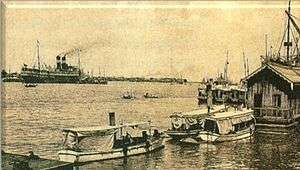1930 Rangoon riots
The 1930 Rangoon riots were a pair of race riots between Indian dockworkers and Burman labourers. The first broke out on 26 May near the Rangoon docks. It spread to nearby districts with high Indian populations and resulted in over one hundred killed and about one thousand injured.[1] The second, a prison riot, began on 24 June in Rangoon Central Jail, where the staff was predominantly Indian and the inmates overwhelmingly Burman.[2] The riots were overshadowed by the Saya San rebellion that erupted in December that year.[2]
| 1930 Rangoon riots | ||||
|---|---|---|---|---|
 Barr Street Jetty and Rangoon River, 1930 | ||||
| Date | 26 May and 24 June 1930 | |||
| Location | Rangoon, British Burma 16°51′N 96°11′E | |||
| Caused by | Disputes over wages and labor rights | |||
| Goals | Higher wages, higher employment | |||
| Methods | Striking, rioting | |||
| Parties to the civil conflict | ||||
| ||||
| Lead figures | ||||
| ||||
| Casualties and losses | ||||
| ||||
In early May 1930—in the midst of the Great Depression—Indian dockworkers in Rangoon went on strike for increased wages. Burman labourers were brought in to break the strike, but the port became congested. An agreement was reached with the Indians to raise their wages, whereupon the Burmans were dismissed. As they returned to work the Indians jeered the outgoing Burmans and violence ensued. For days Burman mobs, often composed of toughs imported from other neighbourhoods, roamed about for Indians, who barricaded themselves in their homes and, in one case, in the local lunatic asylum. Order was only restored when the Rangoon garrison, the Cameron Highlanders, was sent in.[2] According to British colonial government sources, roughly 120 people of Indian origin were killed and more than 900 were injured. However, more recent analyses estimate that more than 200 were killed and 2,000 injured.[3] The majority of all killed and wounded was Indian.[2]
The riot in the jail was a lesser mirror image of the dockyard riots. The Indian prison staff killed, mainly by gunshot, 34 inmates (out of 2,000) and injured 60 others.[2]
Notes
- King 2008, p. 71.
- Brown 2013, pp. 57–58.
- Renaud, Egreteau (19 October 2009). "Burma (Myanmar) 1930-2007". SciencePo. Mass Violence and Resistance - Research Network. Archived from the original on 24 August 2017. Retrieved 19 March 2017.
References
- Brown, Ian (2013). Burma's Economy in the Twentieth Century. Cambridge: Cambridge University Press.CS1 maint: ref=harv (link)
- Chakravarti, Nalini Ranjan (1971). The Indian Minority in Burma: The Rise and Decline of an Immigrant Community. London: Oxford University Press.CS1 maint: ref=harv (link)
- King, Victor T. (2008). The Sociology of Southeast Asia: Transformations in a Developing Region. Copenhagen: NIAS.CS1 maint: ref=harv (link)
- Warren, James (2002). "The Rangoon Jail Riot of 1930 and the Prison Administration of British Burma". South East Asia Research. 10 (1): 5–29.CS1 maint: ref=harv (link)